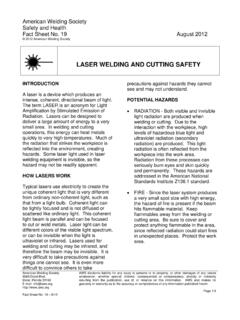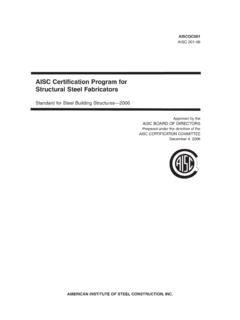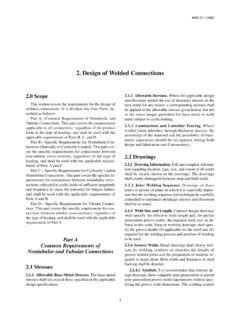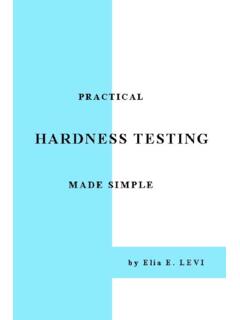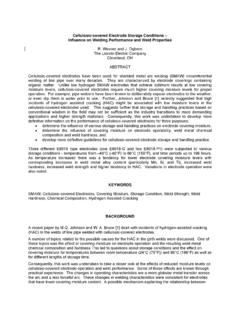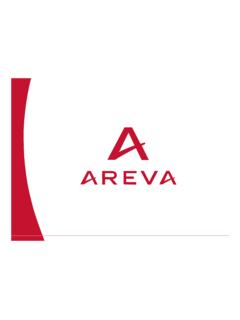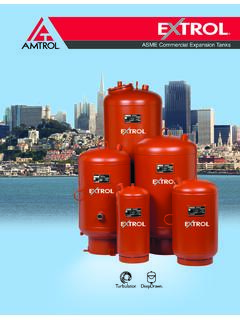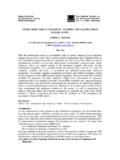Transcription of Essential vs. Nonessential Variables
1 Inspection Trends / July 201020 FeatureBy Albert J. Moore article is the second in a seriesaimed at helping you understand theconcept of Welding ProcedureSpecifications (WPSs), how to write them,and how to use them. This article definesthe differences between Essential andnonessential Variables . Article three willcover qualifying a WPS by testing, andarticle four will help you write a WPS that,in the author s words, will do more thancollect dust. If you look at the label on any fooditem candy bar, cookies, box of browniemix you will see a list of label does not provide the quantity ofeach ingredient, but it does list theingredients in order of the greatest to leastamount used. It would be impossible, basedsolely on the information provided on thelabel, to duplicate the exact recipe themanufacturer welding documents somecontractors provide are a lot like the labelon a box of brownie mix. They list only thebasic information needed to meet theapplicable code, but fail to list importantinformation the welder needs to replicatethe test information should be includedin the welding documentation?
2 Whatinformation is helpful, but not crucial, tomaking an acceptable weld? Volunteerswho sit on the committees that develop ourwelding codes and standards have beendiscussing this subject for many have agreed on common languageand basic definitions, but they do notnecessarily agree on the content of theWPS or how the WPS is to be Variables that are critical tomaking acceptable welds are categorized asessential Variables . Welding Variables thatdo not have a profound influence on themechanical properties of the weld or thosethat are associated with the skills of thewelder are categorized as is an acceptable weld? Onedefinition is a weld that meets theminimum requirements of the applicablewelding standard. The minimumrequirements would include mechanicalproperties such as tensile strength, ductility,and soundness. The welding standard mayinvoke notch toughness requirements whenservice conditions, such as low-temperatureapplications, require toughness.
3 There isnot just one welding standard that issuitable for all applications. Differentservice conditions and applications requiredifferent welding standards. Each weldingstandard has unique requirements forqualifying welding procedures and welders,as well as different fabrication requirementsto satisfy those service requirements. While space limitations prevent usfrom exploring every possible weldingvariable, we can look at several variablesthat play an important role in the depositionof sound welds. In this article, we willcategorize welding Variables as Essential ornonessential using the definitions in thenext paragraph. A word of warning: makesure you review the requirements of theapplicable code or standard whenqualifying or documenting a weldingprocedure, because no two standards are infull agreement when it comes tocategorizing every welding variable aseither an Essential or Nonessential , that as we said previously, Essential Variables are those that have asignificant influence on the mechanicalproperties, such as tensile strength andductility.
4 Nonessential Variables are thosethat do not have a significant influence ontensile strength or ductility of thecompleted weld. Also, those Variables thatare dependent on the welder s skills tomake a sound weld are classified asnonessential VariablesBase MetalsOne of the first factors to considerwhen making a weld is the base metal ormetals to be joined. Some base metals areeasily welded, some are more difficult, andothers are downright ornery to weld. Basemetals are grouped as ferrous or nonferrousmetals. Ferrous metals can be furtherclassified as low-carbon, medium-carbon,high-carbon, high-strength low-alloy, andhigh-alloy steels, as well as ferriticstainless, martensitic stainless, austeniticstainless, duplex stainless, andprecipitation-hardened stainless steels. Thenonferrous metals include alloys ofaluminum, copper, nickel, titanium, andmany more. Some of the nonferrous metalsare further classified as refractory orreactive metals.
5 Welding standards usuallygroup the base metals into families thathave similar chemistry and groups the various base metals byP- or S- numbers. AWS , Specificationfor Welding Procedure and PerformanceEssential vs. Nonessential VariablesCWIs must review the applicable welding standard to determine which welding parametersare defined as Essential , Nonessential , and supplementary Essential variablesMoore Feature Summer 2010:Layout 1 6/24/10 8:50 AM Page 20 Inspection Trends / Summer 201021 Qualification, uses M-numbers andNAVSEA S9074-AR-GIB-010/248 uses S-numbers to group the base metals. Achange from one P-, M-, or S-numbergroup to another affects the mechanicalproperties; therefore, base metals areclassified as Essential ProcessA welding process must be selectedonce the base metal is known. Not all basemetals can be easily welded with everywelding process that is in use. Weldingstandards list the welding process as anessential variable.
6 If you change thewelding process, but nothing else, thechances of obtaining a sound weld with therequired mechanical properties will be inquestion. Consider what happens if wechange from the gas metal arc weldingprocess to the shielded metal arc welding(SMAW) process. That change wouldrequire a change in the type of filler metal,a different power supply, and a switch froma welding gun to an electrode holder. Inaddition, shielding gas is no longerrequired. As you can see from the example,a change in the welding process caninvolve several changes associated with thewelding process. Once the base metal and the weldingprocess are determined, a suitable fillermetal may have to be selected. The fillermetal must be compatible with the basemetal and the welding process. Fillermetals are typically grouped by an F-number based on chemistry, flux type (if aflux system is used to shield the moltenweld pool), and ease of use if it is a SMAW electrode.
7 A change from one F-number toanother will usually result in a change inchemistry and mechanical a switch from an F-6 (low-carbonsteel) filler metal to an F-3X (a copper-based alloy) filler metal. Even if the basemetal and the welding process have notchanged, the mechanical properties surelywill since iron and copper do not play wellwith each other. The F-number is anessential DesignJoint design usually falls into thenonessential variable category. Themechanical properties of the completedweld are not dependent on the groovedesign. Switching from a V-groove to abevel groove is not going to change themechanical properties of the weld. However, there are times when achange in the groove detail will affect theproperties of the welded joint. Consider ajoint between dissimilar base metals. Thetwo base metals have different alloycompositions and different mechanicalproperties. The completed weld is acomposition of both base metals and thefiller metal used.
8 The exact composition ofthe weld (and its mechanical properties) aredependent on the volume of base metalmixed with the volume of filler metal in themolten weld pool. Let s examine a weld joining a sheetof carbon steel (ASTM A36) to a sheet ofstainless steel (ASTM A240 Type 304alloy). The weld joint is a square groovedetail that is joined with a single weld 309 filler metal is typically used for thiscombination of base metals. The completedweld may consist of 40% carbon steel, 40%stainless steel, and 20% filler metal. Nowconsider what happens if the groove designis changed to a V-groove. The completedweld now consists of 15% carbon steel,15% stainless steel, and 70% filler alloy composition of the completedweld has been changed and acorresponding change in the mechanicalproperties of the weld can be Section IX and AWS codes use theA-number to define the chemistry offerrous weld deposits. A change in the A-number results when there is a change inthe chemistry of the weld.
9 A change in weldchemistry will result in a change in themechanical properties, therefore the A-number is an Essential variable. Nonessential VariablesThe welder controls some variablesthat have little impact on the mechanicalproperties of the completed weld. Assumingthe welder is skilled, as demonstrated by hisor her passing the welder performance test, Variables such as arc voltage, amperage, andtravel speed typically have little effect on thechemistry or mechanical properties of theweld. These are usually considered to benonessential Variables . Arc VoltageUsing SMAW as an example,variations in the arc length maintained by askilled welder will result in minorfluctuations in arc voltage. A minor changein voltage is not going to affect the heatinput or the chemistry of the weld depositsufficiently to dramatically alter themechanical properties. Therefore, as wehave defined it, voltage is a nonessentialvariable. Welding AmperageTurning once again to the SMAW example, welding amperage for a givenelectrode diameter is restricted to a narrowrange.
10 If the welder increases amperageabove or below the manufacturer srecommendation, the welding arc becomesunstable and an unacceptable weld that meet the mechanical propertiesof the applicable code can be expected ifthe welder uses the electrode within theamperage range the manufacturerrecommends. In this example, amperage isa Nonessential variable. Travel SpeedAn increase or decrease in the travelspeed has little effect on the mechanicalproperties of the weld assuming voltage,amperage, and the other Variables remainunchanged. For a given electrode diameter,the travel speed is largely dependent on themelt-off rate of the electrode, which is afunction of the amperage. The welder canuse a weave bead or stringer beadtechnique. Either technique can produce asound weld with the mechanical propertiesthe code requires. Since a change in travelspeed does not profoundly affect the weld smechanical properties, travel speed is anonessential variable.
